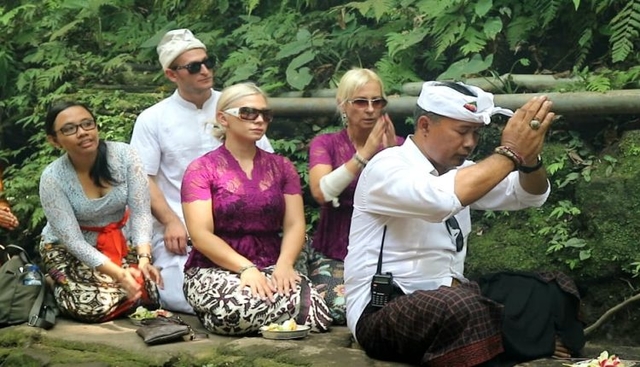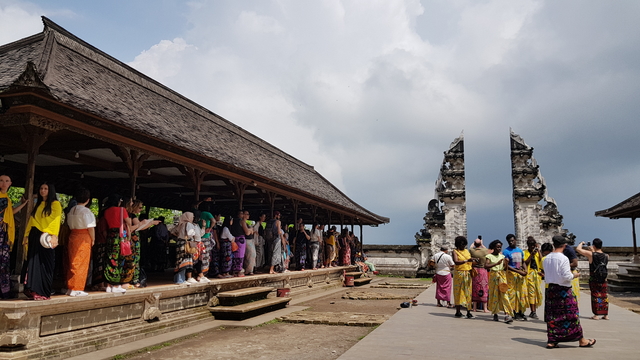Embarking on a journey to Bali offers more than just
picturesque landscapes and luxurious resorts.
Amidst the island's lush greenery
and vibrant markets lie sacred Hindu temples, revered sanctuaries central to
Balinese culture.
To truly appreciate these sacred sites and engage
respectfully with the local community, understanding the etiquette governing
temple visits and cultural interactions is paramount.
In this article, we explore the intricacies of Bali's
etiquette essentials, focusing on temple customs and broader cultural norms, to
ensure a meaningful and respectful exploration of this enchanting island
paradise.

A Tale of Temple Etiquette Gone Awry
In 2019, a scandal emerged when a fitness model visiting a
sacred site in Bali shared a controversial video on her social media platform.
The footage showed her standing at the altar of a temple, lifting her skirt,
and receiving a sprinkling of holy water from her boyfriend.

The video sparked widespread criticism on online platforms,
targeting not just the couple but also their guide. Many questioned why they
weren't cautioned about the inappropriate conduct.
The presence of an official Indonesian guide during the
incident remains unclear, as many tourists explore temples independently.
Even
if a guide is present, their role is to provide general guidance, not to
monitor every action of the tourists.
It's unlikely that a local guide could have anticipated such
behaviour. For instance, it would be unreasonable to expect a guide at the
Louvre to warn you not to strip naked in front of the Venus de Milo statue for
Instagram photos.
Following the incident, authorities ordered the offenders to
fund a cleansing ceremony for the temple.

This story underscores the importance of respecting the
sanctity of temple visits. When planning to explore a Balinese temple or any
sacred Hindu site, it's crucial to recognize its religious significance. Unlike
a museum with secular regulations or a mere backdrop for social media posts, a
temple holds deep spiritual importance and demands reverence from visitors.
If you find the religious guidelines for temple visits in Bali too stringent, it's advisable to abstain from visiting these sites altogether. Visiting a temple without intending to adhere to its customs and rituals disrespects its sacredness.
If you're not religious and view a temple visit as just another
item on your itinerary, it's better to skip it altogether. Opting out of an
experience that holds no profound significance for you ensures you don't
inadvertently disrespect the site's spiritual importance.
Balinese Hindu Temples Visit Etiquette
If you're ready to approach this visit as a conscious
cultural experience, please read the guidelines for visiting Balinese temples
and holy sites before your trip.

Dress Modestly
Above the waist: If you are a foreigner, your shirt
doesn't have to be a traditional Balinese one. For women, it is not mandatory
to wear a traditional blouse known as kebaya. But both men and women
should wear shirts or t-shirts that cover the shoulders.




Below the waist: Both male and female visitors should
wear a sarong and a belt.
Sarong (also known in Bali as kamben or kain
kamben): A properly tied sarong should cover the legs without revealing any
skin underneath. If you're unsure how to tie a sarong properly, don't hesitate
to ask a Balinese for assistance.
Although sarongs are available for hire at some temples, it
is advisable to purchase your own. Having your own sarong not only allows you to enter temples and other public spaces in Bali, such as immigration offices, without restriction, but you can also use it for decorative purposes upon your return home.
The main thing to consider when purchasing a sarong is
whether it is a beach sarong (sarong pantai) or a ceremonial sarong (sarong/kamben
upacara).



A sarong suitable for temple visits is the latter one - sarong/kamben
upacara. It can be bought at a souvenir shop, a store specializing in
ceremonial clothing, or at a market in almost any Balinese village.
Belt (known as selendang or senteng): A
belt looks like a long scarf and is tied around the waist over the sarong.
Footwear: Wearing flip-flops is perfectly acceptable.
Unlike in India, removing your shoes before entering Hindu temples is not
required in Bali.
This simplified version of Balinese attire is sufficient if
you are a tourist wanting to visit a Balinese temple.
Different temples have slightly different requirements. Sometimes, if a man is wearing long trousers, he is
allowed to just tie the belt without the sarong. Other times, just the sarong
without the belt is acceptable.
Note that removing your sarong or belt while visiting the
temple is not allowed. It is also unacceptable to lift your sarong and expose
your legs, even if it's for an exciting photo.
Show Respect
- Keep voices low; shouting or speaking loudly is
discouraged.
- Do not climb on temple structures or statues.

- Use holy water respectfully; for drinking or sprinkling on
face, head, and shoulders only.
- Avoid sitting with legs stretched towards the altar.
- Switch your mobile phone to silent mode upon entering the
temple.
- Avoid posing in yoga positions for photos.
- Seek permission before filming ceremonies; verbal consent
is acceptable.
- Maintain respectful seating posture; ensure your head is
not higher than the priest's head during the ceremony.
- Be mindful not to block worshippers' view of the priest,
especially if you are not actively participating in prayer.
- When all worshippers are seated during the ceremony, it's
best to also remain seated. If you must leave urgently, gracefully indicate
your departure direction by bending down and gesturing with your hand.
- When photographing or filming, minimize noise and avoid
using flash.
- Respect gender norms during seating; women typically sit
on their heels or with legs to one side, while men may sit cross-legged.
- If invited to a ceremony by Balinese acquaintances, it's
customary to stay until the end as leaving early is considered impolite.
- Refrain from public displays of affection such as hugging
and kissing.
- Avoid engaging in intimate acts within temple premises.
(This precaution might seem excessive, but unfortunately, it's necessary due to
past incidents.)
- Refrain from urinating or defecating in or near the
temple.
Entry Restrictions
Entry to Balinese temples is restricted for the following
individuals:
- Women during their menstrual period.
- Individuals with bleeding wounds, irrespective of gender.
- Women within 42 or 105 days after childbirth, depending on
the temple's regulations. The exact duration of the restriction should be
confirmed with your guide or a knowledgeable priest familiar with the temple's
customs.
- Infants under 4 months of age.
- Those who have recently lost a close relative and have not
completed burial/cremation rites.

General Politeness Guidelines
In addition, Bali has general norms of politeness that are
beneficial both during visits to religious sites and in daily interactions.
- Do not touch the heads of Balinese people, including
children. The head is considered sacred. However, be prepared that if you have
a small child, Indonesians may try to gently pinch their cheek.
- Use your right hand when passing items to others or making
physical contact, as the left hand is considered unclean. An exception is when
using both hands to pass something.
- Refrain from pointing with your index finger or beckoning someone with it. Instead, to point, use your thumb while slightly closing the other fingers into a loose fist; to beckon, use your right hand with the palm facing down in a waving motion (a bye-bye gesture in many Western cultures).
- Keep your voice at a calm and respectful level, as raising
one's voice is considered impolite in Balinese culture. Patience and observance
are valued over aggression.
- Respect offerings placed on the ground, especially if
there is still smoke rising from incense sticks. Avoid stepping on them.
- If you encounter a religious procession while on a road,
wait for permission from village guards (men wearing black-and-white checkered sarongs)
to pass or go around it. If you don't speak Indonesian, try to understand their
instructions through visual cues.
Avoiding Cultural Missteps in Bali
Overall, Balinese people are quite tolerant. If you make a
mistake but demonstrate sincerity, kindness, and a genuine effort to behave
politely, they are likely to understand and forgive you.
Balinese people rarely correct or comment on improper behaviour
unless it is particularly blatant.
Instead, if they see indecent or unacceptable actions, they
may record them and share the videos online, often with mocking comments about
the person's country of origin. This can damage your country's reputation and
make you a subject of ridicule, which is quite unpleasant.
To avoid such situations, it's much better to learn about
the traditions and culture of the country you are visiting in advance. This
will help ensure your vacation is enjoyable and conflict-free.
Enjoy exploring Bali and its culture!
You can add one right now!